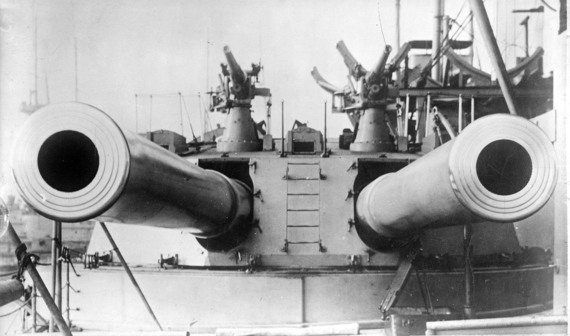The 12 Inch Guns of HMS Dreadnought
The Naval War
The two decades preceding the First World War had witnessed a naval arms race between Great Britain and Germany. Beginning in 1898, Germany had enacted the first of what would eventually be four Fleet Acts. Each act represented an ambitious shipbuilding program designed to greatly expand the German High Seas Fleet. The intent of this policy was unmistakable: to challenge British naval supremacy.
Great Britain responded with the introduction of a new "Dreadnought" class of battleship in 1906. Named after the first ship commissioned, the Royal Navy's HMS Dreadnought, this class of warships boasted an all big gun design with an unprecedented number of large caliber guns. The revolutionary steam turbine propulsion delivered superior speed, an advantage which was further enhanced when the switch from coal to fuel oil further improved both the speed and the cruising range of the new ships.
In naval design, historically, military planners opted for either big guns, whose range allowed a ship to engage an enemy before they could in turn engage them, or speed in order to move away from superior firepower. By offering both improved long range firepower and speed, the new class of "super battleships" instantly made all previous existing warships obsolete. The resulting naval arms race was an important contributor to the heightening tensions that led to the outbreak of war.
Naval warfare during the Great War mainly consisted of an ongoing effort by the Allied Powers to blockade the Central Powers and deprive them of needed foodstuffs and raw materials. Germany in turn relied on its submarine fleet, supplemented by fast cruisers designated as "commerce raiders," in its bid to isolate Britain and France from their overseas suppliers as well as to attack their surface fleets.
There were also a number of fleet actions. Encounters took place mainly around those countries and in the Atlantic Ocean, although the Baltic Sea, Black Sea, the Mediterranean Sea and the Indian Ocean saw major action. There were few examples of combined land and sea operations. Gallipoli, being the most noteworthy example, ended in failure. There were also a number of instances, most notably in the defense of the Suez Canal in the Sinai, when naval guns were brought to bear in support of land campaigns, but even those tended to be the exception.
At the start of the war the international treaty obligations towards merchant vessels, including neutrals, were clear. If a merchant ship was intercepted on the high seas, whether by a surface warship or a submarine, the "Prize Rules" applied. These stated that a submarine must surface and order a suspect ship to stop. If the merchantman complied and offered no resistance, then she could be boarded. If contraband - defined as not only armaments and raw materials but also grain, foodstuffs and fertilizer - was found, the crew had to be placed in a place of safety, which included a lifeboat, before the vessel could be sunk. From the very beginning these rules were only haphazardly enforced.
For the first two and a half years of the war German submarines focused primarily on the ships of the Allied Powers. Some neutral vessels, however, were attacked without warning. Merchant ships from powerful neutrals like the United States were generally afforded more protection. Ships from smaller neutral countries were not as fortunate. The fact that the free passage of neutral ships could be restricted in such a way caused much resentment, particularly in the United States.
HMS Dreadnought on Maneuvers, 1906
The First Fleet Action
The first significant sea engagement of the war took place on August 28, 1914. The Battle of Heligoland Bight saw the Royal Navy attacking German Navy ships in the North Sea, off the coast of northwest Germany. The Royal Navy's Harwich Force consisted of two light cruisers and two flotillas of 31 destroyers, with the First Battle Cruiser Squadron - two battleships and three battle cruisers - acting as cover.
Having sunk two German torpedo boats, the British found themselves outgunned and called for assistance. Vice-Admiral David Beatty duly brought a covering squadron to help. By the time the Germans retreated they had lost seven cruisers and 1,200 men. Beatty's reputation was enhanced by his timely action. He would go on to command a much larger First Battle Cruiser Squadron at the Battle of Jutland, where his aggressive actions were in sharp contrast to the more cautious approach of his commander Admiral Sir John Jellicoe. Notwithstanding his reputation for brashness, he would go on to succeed Jellicoe and be promoted to the position of Commander-in-Chief of the Grand Fleet later in the war.


